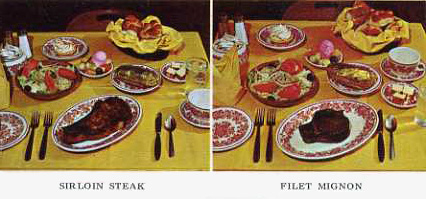 Until I moved to Boston in the 1980s and took a whale watch tour I hadn’t heard the boastful term “biggest grossing” thrown around. In pointing out the highlights of the Boston Harbor, the tour operator singled out several booming enterprises including Anthony’s restaurant. Had we been on a tour of Route 1 north of Boston, I’m sure he would have shouted the praises of the Hilltop Steak House, another mega-volume eatery, where a team of in-house butchers carved up millions of steaks a year, the parking lot held 1,000 cars, and customers waited in long lines outside the door.
Until I moved to Boston in the 1980s and took a whale watch tour I hadn’t heard the boastful term “biggest grossing” thrown around. In pointing out the highlights of the Boston Harbor, the tour operator singled out several booming enterprises including Anthony’s restaurant. Had we been on a tour of Route 1 north of Boston, I’m sure he would have shouted the praises of the Hilltop Steak House, another mega-volume eatery, where a team of in-house butchers carved up millions of steaks a year, the parking lot held 1,000 cars, and customers waited in long lines outside the door.
I never went there. I was not one of the 2,350,000 or so customers who patronized the Hilltop in 1985, for example, one of a number of years when it ranked as the #1 independent restaurant in the USA from a high-grossing perspective, with over $24 million in annual sales.
 Established in 1961 with seating for 125, the Western-themed restaurant continued to grow in subsequent years, with more dining rooms brightened with the standard steakhouse blood red color scheme, seating 1,100 by 1970, with an enlarged parking lot, and a huge 68-foot high lighted cactus sign out front.
Established in 1961 with seating for 125, the Western-themed restaurant continued to grow in subsequent years, with more dining rooms brightened with the standard steakhouse blood red color scheme, seating 1,100 by 1970, with an enlarged parking lot, and a huge 68-foot high lighted cactus sign out front.
Dining rooms were adorned with totem poles, reproductions of Remington and Russell paintings, and life-size Indian figures. The rooms had names meant to conjure up the Wild West such as Sioux City and Kansas City. No doubt the names rang true to diners from New Hampshire and Massachusetts but would have amused residents of those Iowa and Missouri cities which are conspicuously lacking in Western symbology.
Guests appreciated big steaks, low prices, and free parking. Prices were premised on sales volume, rapid table turns, cash-only payment, no reservations, and limited menu choices. Steaks could vary in grade, customers could not send back too-well-done steaks, orders could not be split, and there were no tablecloths. There was only one salad dressing and appetizers and desserts were uninspired – Jello was one of the three desserts on a 1981 menu. “I have nothing against lobster thermidor,” owner Frank Giuffrida told a reporter in 1984, “but don’t come to the Hilltop Steak House and expect to find it.”
The restaurant was prominently visible on Route 1’s tacky, wacky restaurant row where other high-grossing restaurants were also located, making the roadway a New England phenomenon in its own right. The Hilltop’s location was conveniently near the Mystic Bridge, the Callahan and Sumner Tunnels, Logan Airport, the Southeast Expressway, and Routes. 128, 28, 3, and 93. Busses were welcome!
The Hilltop’s founder, Frank Giuffrida, owned the restaurant until 1988, retiring as a rich man despite never having attended high school. In 1940, when Frank was 23, he was a butcher in the family meat market. His parents were born in Italy and had once toiled in a Lawrence MA woolen mill. In the 1950s he owned a tavern-style eatery called the Hilltop Lounge not far from where the steakhouse would be located.
Frank sold the Hilltop corporation in 1988 though he held onto the building and the large plot of land it occupied. The sale came with an agreement that the Giuffrida family would eat at the restaurant for free for the rest of their lives and that they would never have to wait in line for a table.
 By the late 1990s restaurant competition on Route 1 had grown fierce. Weylu’s, another Route 1 top-grosser serving as many as 5,000 meals a day at its peak, went into bankruptcy in 1999 and closed. The Hilltop shrank its seating capacity to a mere 850 guests, but carried on until 2013. Both Weylu’s and the Hilltop have been demolished.
By the late 1990s restaurant competition on Route 1 had grown fierce. Weylu’s, another Route 1 top-grosser serving as many as 5,000 meals a day at its peak, went into bankruptcy in 1999 and closed. The Hilltop shrank its seating capacity to a mere 850 guests, but carried on until 2013. Both Weylu’s and the Hilltop have been demolished.
© Jan Whitaker, 2017

















 It's great to hear from readers and I take time to answer queries. I can't always find what you are looking for, but I do appreciate getting thank yous no matter what the outcome.
It's great to hear from readers and I take time to answer queries. I can't always find what you are looking for, but I do appreciate getting thank yous no matter what the outcome.


